#Asafoetida (hing)
Explore tagged Tumblr posts
Text
"Hing: The Ayurvedic Treasure for Flavor and Wellness!"
Description:
Elevate your culinary creations and health with IndianJadiBooti Hing (Asafoetida)! Known as the "spice of life," hing enhances digestion, reduces bloating, and adds a distinct, irresistible flavor to your recipes. This 100% natural Ayurvedic ingredient is a must-have for every kitchen, offering not just taste but therapeutic benefits for a healthier lifestyle. Experience the purity and power of Hing from IndianJadiBooti today!
contact us - 9958922111
Shop now at
#Tags:
#Hing#Asafoetida#IndianJadiBooti#AyurvedicSpices#DigestiveHealth#HealthyLiving#NaturalFlavors#CulinaryDelight#HerbalWellness#BloatingRelief#TraditionalSpices#ayurvedic#ayurved#ayurveda#ayurvedic herbs
0 notes
Text
South Indian Lemon Rice
#Asafoetida (hing)#Boiled small rice#Chana dal (split chickpeas)#Curry leaves#Dry Red Chili#Fry curry leaves#Fry green chilies#Juice of lemon#Mustard seeds#Peanuts#Salt to taste#Sesame oil#turmeric powder#Urad dal (split black gram)#Water
0 notes
Text

Buy best hing(Asafoetida) online
Check pure afghani Hing, best in market, shop online today from Ghasphus or contact us 9310257744
For more details visit Ghasphus
0 notes
Text
A Comprehensive Guide to Buying Premium Hing Online
If you are a culinary enthusiast or someone who appreciates the rich, complex flavors in traditional dishes, Hing is likely a staple in your kitchen. Known also as Asafoetida, this spice, despite its pungent aroma, transforms dishes with its unique taste. This comprehensive guide will walk you through everything you need to know about buying premium hing online, ensuring you get the best quality for your culinary needs.

Introduction to Hing
Hing, or Asafoetida, is a resin obtained from the roots of Ferula plants. It has been used for centuries in cooking and traditional medicine, especially in Indian cuisine, where it is revered for its ability to add umami and depth to a variety of dishes. Historically, Asafoetida has also been used as a digestive aid and for its anti-inflammatory properties.
Benefits of Premium Hing
Opting for premium hing over regular varieties can significantly enhance your cooking experience. Premium Hing is known for its stronger flavor and aroma, which means you need less to achieve the desired taste. Additionally, high-quality Hing is often purer, free from additives and fillers that can dilute its potency. This not only results in better flavor but also ensures you reap the maximum health benefits.
Identifying Premium Hing
When looking to buy Hing online, it's essential to know how to identify premium Hing. Purity is paramount – check for products that do not contain added starches or flours. The color should be consistent with the natural hues of Hing, typically a pale yellow or brown. The texture can vary, with solid Hing (in its resin form) often preferred by purists for its potency. The aroma should be pungent and strong, a sign of its quality.
Different Types of Hing
There are several types of Hing available:
Hing Kabuli Sufaid (White Hing): Known for its milder flavor and commonly used in vegetarian dishes.
Hing Lal (Red Hing): This type is more potent and used in non-vegetarian recipes.
Compounded Asafoetida vs. Pure Asafoetida: Compounded varieties are mixed with other substances, while pure forms are more concentrated and usually more expensive.
How to Buy Hing Online
When you decide to buy Hing online, choosing a reliable source is crucial. Look for established online stores and marketplaces with positive customer reviews and high ratings. Compare prices to ensure you're getting a fair deal, but remember that with premium Hing, you often get what you pay for. Check the shipping and return policies to avoid any inconveniences. Some stores offer bulk purchase options and discounts, which can be economical if you use Hing frequently.
Ensuring Authenticity and Quality
To ensure you are getting authentic premium Hing, purchase from certified sellers. Look for labels and product descriptions that detail the purity and origin of the Hing. Authenticity seals or certifications from recognized bodies can also be a good indicator of quality. For instance, Garni Foods is a company known for its high standards in sourcing and selling spices.
Storing Hing
Proper storage of Hing is essential to maintain its freshness and potency. Store Hing in an airtight container in a cool, dry place away from direct sunlight. Different forms of Hing, such as powdered or solid Hing, have varying shelf lives, but generally, they can last for several months if stored correctly.
Using Hing in Cooking
Hing is a versatile spice that can elevate many dishes. It is commonly used in Indian cuisine, especially in lentil dishes like dal, vegetable curries, and pickles. When cooking with Hing, a little goes a long way. Usually, a pinch of strong asafoetida is enough to impart its distinct flavor. It can also be combined with other spices such as cumin, coriander, and turmeric to create complex flavor profiles.
Health Precautions and Considerations
While Hing has many health benefits, it's important to use it in moderation. Some individuals might be allergic to asafoetida and could experience reactions such as stomach upset or skin irritation. It's advisable to consult with a healthcare provider if you are pregnant or breastfeeding before adding Hing to your diet.
Conclusion
Hing is an invaluable spice that not only enhances the flavor of dishes but also offers several health benefits. By understanding how to identify and buy premium Hing online, you can ensure you are getting the best quality product. Remember to store it properly and use it sparingly to enjoy its full potential. Happy cooking!
0 notes
Text
Hing/Asafoetida 50g | Buy Hing from Garni Foods
Hing, also known as asafoetida, is the unsung hero of Indian cuisine, revered for its ability to elevate dishes to new heights of flavor. At Garni Foods, we present you with the finest quality hing that guarantees to infuse your cooking with authentic taste and aroma.
Our hing is carefully sourced and processed to ensure maximum potency and freshness. Whether you're a culinary enthusiast or a professional chef, our hing 50g packs are perfect for adding that extra punch to your recipes.
Join countless culinary enthusiasts who trust Garni for their spice needs. Elevate your dishes to new heights with Garni Hing and unlock a world of tantalizing flavors. Try Garni Hing today and discover the difference it can make in your cooking!
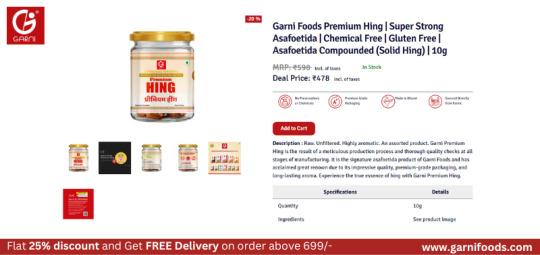
0 notes
Text
Asafoetida benefits for male and female fertility: A Review of Studies on its effect on libido
Asafoetida, which we popularly call Hing, is a resin derived from the roots and stems of several ferula plants. It has a very strong pungent odor, often described as resembling garlic, sulfur, or cheese. Asafoetida Medicinal Uses and Benefits If you are asking what is asafoetida used for? Hing has several pharmacological properties in addition to being used as a spice in various cuisines,…
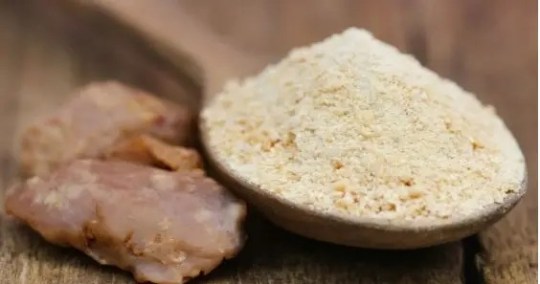
View On WordPress
#Asafoetida benefits for libido#Asafoetida benefits for male and female fertility#Asafoetida for fertility#Hing benefits for male
0 notes
Text
توجه: عبارت "گیاه انغوزه" صحیح نیست؛ چرا که "انغوزه" نام شیره ای است که از گیاه مولد استحصال می شود که در این مقاله با هر دو گونه اصلی این گیاه آشنا خواهید شد. امّا در این مقاله، جهت سهولت در خوانایی محتوا، به جای نوشتن عبارت "گیاه مولد انغوزه" نوشته ایم " گیاه انغوزه" بنابراین هر جا عبارت "گیاه انغوزه" یا "آنغوزه گیاهی..." را مشاهده کردید، منظور همان گیاهی است که شیره انغوزه از آن استحصال می شود.
شیره انغوزه در برگ های گیاه مولد ساخته شده و به ریشه انتقال می یابد که با تیغ زدن ریشه خارج می شود.
شیرابه انغوزه در پزشکی نوین کاربردهای زیادی دارد که در این مقاله با تعدادی از آن ها نیز آشنا خواهید شد.
شیره انغوزه مایعی صاف، بی رنگ یا سفید و یا به رنگ زرد روشن یا قهوه ای با بوی بسیار بد است که در مقابل هوا به سرعت اکسیده می شود.
به طور میانگین هر گیاه انغوزه بین 20 تا 40 گرم شیره دهی دارد و از شیره آن ده ها نوع ماده دارویی ارزشمند به دست می آید که متأسفانه به دلیل نبود صنایع تبدیلی در ایران، به صورت خام به سایر کشورها صادر می شود.
توجه: بنا به نظر کارشناسان شرکت فایدیم، هنگام خرید بذر آنغوزه دقت کنید و بذر مورد نیاز خود را از کارشناسان متخصص که نسبت به منطقه و ارقام مختلف بذر اشراف دارند، خریداری کنید. همچنین از کشت و رواج ارقام بیگانه بویژه در مراتع خودداری کنید.
گیاه انغوزه (انقوزه)، گیاهی است چند ساله که در ایران دارای پراکنشی بسیار گسترده است و از سال های بسیار دور تاکنون، جزء اقلام مهم و شاخص گیاهان دارویی و صنعتی ایران محسوب می شده است.
توجه: جهت خرید شیره انغوزه و یا اطلاع از قیمت هر کیلو شیره انغوزه ۱۴۰۲، لطفاً یک درخواست رسمی برای ما ایمیل ([email protected]) کنید تا بررسی کرده و پاسخ دهیم.
شیرابه انغوزه به عنوان آنتی اسپاسمودیک در موارد زیر مصرف دارویی دارد:
برطرف کننده انگل های گوارشی روده
بادشکن
خلط آور
در حال حاضر در ایران، اهمیت عمده آنغوزه به لحاظ صنعتی - اقتصادی، به علت ارزش صادراتی آن است.
میزان شیره دهی انغوزه توسط هریک از گونه های مولد، می تواند تحت تأثیر پارامترهای زیر متفاوت باشد:
سن گیاه هنگام استحصال شیره انغوزه
روشی که ریشه گیاه برش زده می شود
تعداد برش در طول دوره بهره برداری
قیمت هر کیلو شیره انغوزه 1402
قیمت انغوزه در ایران از پارامترهای خاصی پیروی می کند که در ادامه شما را با مهم ترین آن ها آشنا خواهم کرد:
نوع شیره انغوزه (شیرین یا تلخ)
ناحیه استحصال یا تراوش شیره انغوزه از گیاه (اشکی یا خمیری)
الگوی کشت (زراعی یا کوهی)
زمان بهره برداری
مختصات و منطقه بهره برداری
درجه خلوص (تمیز بودن و عدم وجود ناخالصی هایی که ممکن است در اثر جریان باد به داخل شیره نفوذ کرده باشند)
تفاوت انغوزه اشکی و کُنده ای
انغوزه اشکی را می توان محصول زود بازده گیاه آنغوزه دانست.
انغوزه اشکی حاصل:
برخورد سنگ ریزه ها به ساقه گیاه آنغوزه هنگام وزش بادهای شدید، در فصولی که شیره در ساقه گیاه جریان دارد.
نیش حشرات
ایجاد برش های ریز به واسطه تیغ بهره برداران بر روی ساقه گیاه (به ندرت)
شیره انغوزه پس از خروج از ساقه در معرض هوا به سرعت اکسید شده و سفت می شود.
این انغوزه به دلیل آن که کم ترین میزان ناخالصی را در خود دارد، از قیمت بیش تری برخوردار است. در حقیقت سرعت بالای اکسید شدن، مانع از این می شود که ناخالصی های زیادی درون این صمغ، زمانی که هنوز حالتی مایع دارد، نفوذ کند.
میزان برداشت این آنغوزه نسبت به نوع برداشت شده از ریشه، چندان زیاد نیست.
بهترین زمان جهت برداشت انغوزه اشکی که قیمت قابل توجهی نیز دارد، معمولاً سال آخر عمر گیاه انغوزه است که تولید ساقه می کند؛ چرا که جمع کردن آنغوزه اشکی در اوایل عمر گیاه از بوته های روی زمین کمی سخت است.
انغوزه اشکی در سال آخر از قرنه (ساقه گل دهنده) جمع آوری می شود.
انواع آنغوزه در ایران
انغوزه تلخ: Ferula assa-foetida
انغوزه شیرین: Ferula foetida
طعم انغوزه تلخ و شیرین
شاید این ابهام برای شما نیز ایجاد شده باشد که آیا واقعاً آنغوزه تلخ طعم تلخی دارد و آنغوزه شیرین طعمی شیرین؟
در پاسخ باید عرض کنم که خیر.
طعم آنغوزه شیرین: تند.
طعم آنغوزه تلخ: تلخ با ته مزه تند.
انغوزه چیست؟
نام های انگلیسی:
Asafoetida
Asafetida
Anghoza (بیشتر تجار پاکستانی از این عبارت استفاده می کنند)
Food of the Gods
نام های محلی در ایران:
کما
هنگ
هنگو
گنابو
گنده بو
پترک (رایج در استان سیستان و بلوچستان)
مشخصیات گیاه شناسی:
انغوزه گیاهی خودگشن است؛ یعنی گیاهی است که مادگی آن با گردۀ گل همان گیاه بارور شود.
آنغوزه از گیاهان دارویی مهم تیره چتریان می باشد. یکی دیگر از اعضای این خانواده را که آن هم از صمغ های ارزشمند ایران می باشد، در مقاله زیر به طور کامل معرفی کرده ام.
این گیاه علفی چند ساله کرک دار، بوته ای یا درختچه ای و مونوکارپیک است.
برای مطالعه ادامه این مقاله به وب سایت فایدیم مراجعه کنید و یا روی لینک زیر کلیک کنید:
قیمت هر کیلو شیره انغوزه
منبع: فایدیم
0 notes
Link
#Antioxidants#Asafoetida#cookingtips#digestion#healthbenefits#hing#immunesystem#Indianspices#inflammation#pungentflavor
0 notes
Text
Buy authentic asafoetida online from Farmonics
One of the most basic spices in Indian cuisine, asafoetida / hing, has long been a staple of our culinary heritage. The extremely powerful and pungent spice gives our dish a tonne of flavour and scent. Practically every Indian home contains whole hing asafoetida. This spice is employed in pickling, as a condiment on food, and as a digestive aid. As a savoury enhancer, it plays a vital flavouring role in vegetarian Indian cuisine. Hing sabut is a common ingredient in vegetable recipes, particularly those based on potato and cauliflower, as well as lentil curries like dal and chickpea curries when used in conjunction with turmeric. Buy authentic asafoetida online from Farmonics.

0 notes
Text
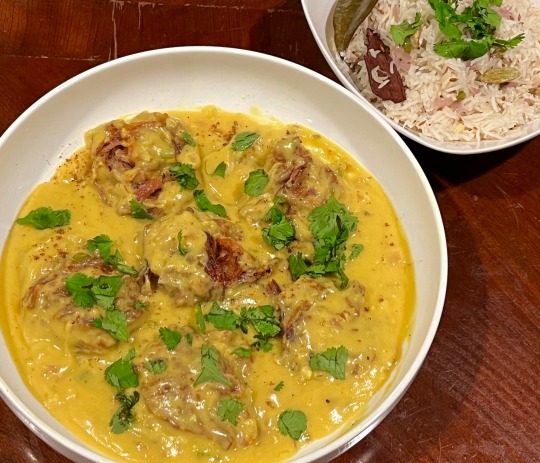
[ID: A large, shallow bowl filled with a bright yellow curd and golden brown pakora garnished with cilantro. A small bowl of jeera rice with green cardamom, cinnamon, bay leaf, and cilantro sits to the right. End ID.]
Vegan Punjabi kadhi pakora / ਪੰਜਾਬੀ ਕੜ੍ਹੀ ਪਕੌੜਾ
Kadhi is a comfort food popular in north and central India and southeast Pakistan. The base of the dish is spiced curd or buttermilk, to which chickpea flour, vegetable fritters, and spiced tadkas (temperings) are sometimes added. Unlike the sweeter, thinner, and unadorned variations to the south, Punjabi kadhi is slowly reduced to a thick, creamy consistency and studded with onion pakoras.
Recipe under the cut!
Patreon | Tip jar
For the pyaaz ke pakore (onion fritters):
1 cup besan (chickpea flour)
2 medium yellow onions, thinly sliced
1/2 tsp table salt
1/2 tsp mirchi (ground red chilis)
1/2 tsp ajwain (carom seeds)
A couple cups of a neutral oil, for frying
For the curd:
1 cup (220g) unflavored vegan yoghurt
1/2 cup (60g) besan
1/2 tsp amchur (dried mango powder; optional)
4 cups water
In Punjab, kadhi is often made with full-fat buttermilk, and sometimes with yoghurt. Vegan yoghurt (I used oat) will provide a similarly smooth, fatty, slightly sour base.
Adding less water to the curd mixture will allow it to cook down faster if you’re short on time; but a long, slow simmer is more typical with this dish.
For the kadhi:
2 Tbsp neutral oil
Pinch hing (asafoetida)
1 medium yellow onion, chopped
2-inch piece (20g) ginger, minced
4 cloves garlic, minced
2 green chilis, chopped
2 tsp cumin seeds (jeera)
1/4 tsp fenugreek seeds (methi)
1 tsp ground coriander
1/2 tsp mirchi (ground red chilis)
1/2 tsp ground turmeric
1/2 tsp garam masala
3/4 tsp table salt, or to taste
Mustard oil is typical, but any neutral oil (sunflower, canola, vegetable) will work.
For the tadka (optional):
1 Tbsp non-dairy margarine
1 tsp cumin seeds
1 dried red chili
1/2 tsp mirchi
Instructions:
1. Start the pakore. Cut onions in half through the root and lay cut-side down. Slice thinly vertically (perpendicular to the root) and then cut the root off. Whisk together other pakora ingredients (except for the oil) in a large bowl; add the onions and toss well to combine. Cover and set aside for 30 minutes to allow onions to release moisture.
2. Make the curd mixture. Whisk yoghurt and besan together in a large bowl. Add amchur (or substitute apple cider vinegar) if the yoghurt you are using is not particularly sour, to taste. Add water and whisk until a smooth mixture forms. Set aside.
3. Make the kadhi. Heat 2 Tbsp of a neutral oil in a large pot on medium-high. Fry fenugreek and cumin seeds for a few minutes until they are fragrant and popping into the air.
4. Add hing and cook for 30 seconds. Add onion, chili, and salt and saute for 3-4 minutes, until onion is translucent.
5. Add ginger and garlic and sauté for 30 seconds to a minute, until no longer raw-smelling. Add coriander, mirchi, and turmeric and sauté another 30 seconds.
6. Add the curd mixture and stir to combine. Allow to come to a boil, then lower the heat to low and allow it to cook, stirring occasionally, for 30-45 minutes, until thickened.
7. Meanwhile, finish the pakore. Stir the onion slices to distribute any moisture they may have released. Add just enough water to hydrate all the besan and allow the pakoras to hold together.
8. Heat about an inch of neutral oil on medium in a large pan. Once hot, drop small handfuls of pakora mixture into the oil. Fry, flipping once, until golden brown on both sides. Remove onto a paper-towel-lined plate or wire rack.
9. Add pakoras to the kadhi, along with garam masala, and allow to simmer for another 5-10 minutes until kadhi is very thick and creamy. Remove into a serving dish.
10. Make the tadka. Heat margarine in a small skillet until sizzling. Add cumin seeds, chili pepper, and mirchi and heat until fragrant. Pour the oil, seeds, and chili over the finished kadhi and serve immediately.
Serve with roti, paratha, rice, or jeera rice.
#recipes#vegan recipes#cooking#Indian recipes#Indian#Punjabi#yoghurt#yogurt#besan#chickpea flour#pakora
359 notes
·
View notes
Text
My low fodmap dudes, if you're wondering how to do without garlic and onion, I have some (reasonably) good news!
I thought not being able to have onion and garlic would be the worst - and it still is, when I'm eating out, because they're in everything - but for cooking at home purposes it turns out I don't miss them at all, because I have garlic oil and asfoetida/hing.
Pretty much everyone knows about garlic infused oil, I guess. You can buy it at a regular supermarket, and it gives the garlic taste without containing the garlic fodmaps.
But for the onion taste, you can substitute asafoetida, also known in Indian spices as Hing

It's a bit stinky--it has a sulfurous, rotten egg scent--and it's very strong. I had been putting a teaspoon of it in my stews and it left a metallic taste. But now that I've discovered it only takes a pinch of the stuff to give the taste of a whole onion, it's my best friend.
Warm your garlic oil in the pan, cook the pinch of hing for thirty seconds or so, add the rest of your spices and then chuck everything else in as per usual. You won't miss onion again.
14 notes
·
View notes
Text
Pierogi & Kielbasa Curry
This is a Polish-Indian fusion dish that is one of my favorite meals to make. The Gujarati spice base with Polish staples makes for a very tasty and hearty stew-like curry. Enjoy :)
NB: If an ingredient doesn't have an amount next to it, it is intended to be eyeballed to the maker's preference. Additionally, be sure to check the footnotes at the bottom before asking any questions. My inbox is always open.
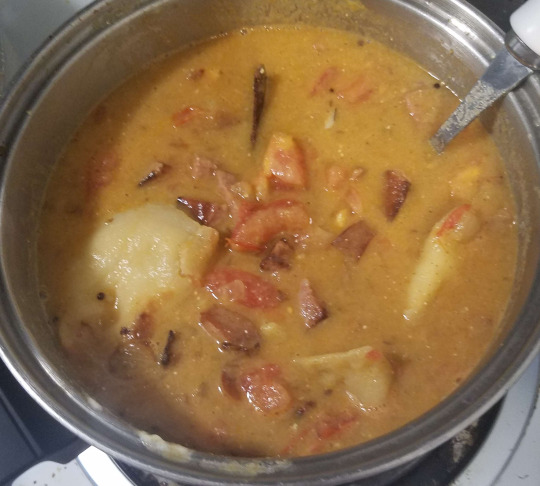
Ingredients
Vaghar Vegetable Oil 1 Cinnamon stick 5-10 Cloves Cumin seeds Black mustard seeds Fenugreek seeds 1 Dash of hing (asafoetida) (1)
Contents 1 Onion Garlic (2) 12 Potato & Farmer's Cheese Pierogi (3) 1 Kielbasa (14 oz.) (4) 2 Tomatos Water ~1 tsp. Tomato paste
Spices and Thickeners Cumin powder Coriander powder Paprika Garam masala (5) Chili powder (6) ~1 cup Sour cream (7) Potato Flakes
Instructions
Start by mincing the garlic and dicing the onions and tomatos. Then Put them to the side. To make the vaghar, put the vegetable oil in a large pot over medium heat. After about a minute of letting it heat up, add all of the whole spices to the pot (cinnamon, cloves, cumin seeds, mustard seeds, and fenugreek seeds). Stir the spices a little to make sure they are coated in the oil. Once the cumin seeds begin to toast and change color, add the hing and stir again. The goal here is to infuse the oil with the flavor of the spices, so once you feel that has been accomplished(8), add the garlic and onions and begin sauteing(9).
Once the onions start to brown, add the kielbasa and all of the pierogi. Be sure to stir carefully so as to not poke holes in the pierogi, and make sure there is enough oil to prevent the pierogi from sticking and tearing open. If you notice things starting to stick, add more vegetable oil. Ultimately, the goal at this stage is to fry the pierogi skins to prevent them from becoming soggy after you add the water and infuse the pierogi and kielbasa with the flavor of the spices. Once you feel that is done, add the diced tomatos (juice and all) to the pot, and fill with water until everything is covered. add the tomato paste and stir.
Add all of the ground spices (cumin, coriander, paprika, and garam masala, and chili powder(10)) and stir. Turn the stove up to high, and stir. Continue to stir carefully so as to avoid tearing pierogi, and try diligently to keep things off the bottom of the pot because they will stick easily. Once the curry starts to boil, turn the heat down to low/simmer and add the sour cream. Once you are happy with the amount of sour cream you have added, thicken the curry the rest of the way to your preference with the potato flakes.
Footnotes
Ingredients (1) If you cannot obtain the hing or garam masala, don't sweat it. They are not integral parts of the recipe. (2) Feel free to economize anything in this recipe. I frequently use garlic powder instead of garlic and canned diced tomatos when I am busy. The recipe above in its current form is intended to represent the freshest possible version of it. Do not drive yourself crazy trying to make it perfect. (3) Be careful with pierogi that simply call themselves "potato and cheese." I know at least in the United States a lot of the potato and cheese pierogi use cheddar, which would not work for this recipe. Alternatively, you could use plain potato pierogi and make the farmer's cheese yourself (to my knowledge all you have to do is boil milk, add sour cream till it curdles, and strain the curds) and add it seperately to the curry. (4) Preferably, use turkey or chicken kielbasa to avoid accidentally committing a heresy against one of the two cultures this dish is from. (5) Generally, its highly unusual for turmeric to be lacking from the list of spices in a curry like this, but in my earliest attempts with this recipe, I noticed it was clashing with the spices usually found in kielbasa. If you want to try adding it anyways, be my guest. (6) I actually usually don't add chili powder since this curry is already naturally so mild I most often make it for spice-averse audiences, but hypothetically just chili powder shouldn't really increase the heat much because of all the dairy. Therefore, if you're interested in making this recipe with all the heat of a traditional indian curry, I recommend adding a few whole, dried red chilis to the vaghar as well as a tablespoon of chili garlic sauce when you start cooking the onions. (7) 1 cup is what i most commonly add, but really how much you want to add is entirely dependent on how much you like sour cream. You could easily put in 2 cups as well. You could also put in 1/2 a cup and and have sour cream available for people to add to their individual bowls. Instructions (8) the other goal here is to not burn the spices. It can be a fine line trying to infuse as much of their flavor as possible into the oil without overheating them. All you can do is try to gauge if its infused by smell. Ultimately, if the scent of the vaghar becomes smoky, just add the onions immediately to prevent any further burning. (9) I also like to add a small amount of all the ground spices (cumin, coriander, paprika, and garam masala) or a teaspoon of curry paste to the onions here as well. This helps give the onions, kielbasa and pierogi more of that flavor, but it also absorbs oil and makes things easier to stick the bottom of the pot, so judge for yourself whether its worth it. (10) see 6. It is not necessary to add the chili powder unless you like heat.
27 notes
·
View notes
Text
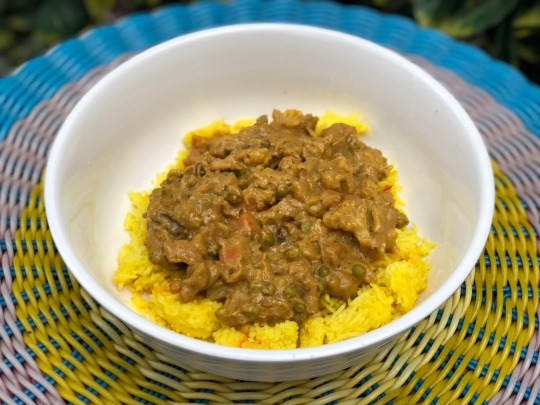
Veggie Korma
[[MORE]]
1 tbsp butter-flavoured coconut oil 1 onion, peeled and chopped
1 tbsp garlic paste 1 tbsp ginger paste
2 cups tomatoes, chopped
1 tbsp coriander 1 tbsp cumin 1 tsp garam masala 1 tsp cardamom 1 tsp turmeric 1 tsp fennel powder 1 tsp Kashmiri red chili powder 1 tsp sea salt
1 cup raw cashews 1 can coconut cream 1 tbsp maple syrup
Heat coconut oil in a large saucepan over medium-low heat. Sauté onion for several minutes. Stir in the garlic paste and ginger paste and sauté for another minute or two.
Stir in the tomatoes and cook for about five minutes, stirring frequently. Add the; coriander, cumin, garam masala, cardamom, turmeric, fennel, chili powder, and sea salt. Cook for several more minutes, stirring frequently. Turn heat off. Allow to cool.
Place cooked tomato mixture into a high-speed blender. Add the raw cashews, coconut cream and maple syrup. Blend until smooth and creamy.
2 tbsp butter-flavoured coconut oil
1/2 head of cauliflower, chopped 1 1/2 cup sweet potatoes, peeled and chopped 1 1/2 cup carrots, peeled and chopped 2 cups vegetable bouillon 1/2 cup raisins
1 cup green peas 1/2 cup roasted cashews, chopped 1 tbsp cilantro paste a pinch of hing (asafoetida)
Heat coconut oil in a large saucepan over medium-low heat. Make sure it coats the bottom of the pan. Add the; cauliflower, sweet potatoes and carrots. Pour the pureed sauce over top. Stir in the vegetable bouillon and raisins. Turn heat to high. As soon as mixture begins to bubble turn to low heat and simmer for about 15 minutes, stirring frequently. When veggies are fork tender, turn heat off.
Stir in the; green peas, roasted cashews, cilantro paste and hing. Allow to sit for a few more minutes to heat the peas. Ladle over basmati rice.
#veggie korma#vegan veggie korma#vegan indian#vegetable korma#vegan vegetable korma#korma#vegan curry#vegan stew#curry#vegetable curry
9 notes
·
View notes
Text
Unlocking the Flavors of Rayalaseema: How to Make Super Delicious Kurnool Special Uggani
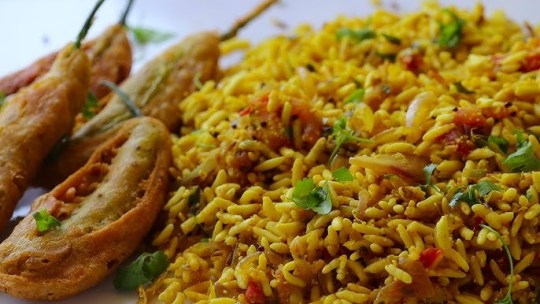
Rayalaseema, a region in the southern part of India, is renowned for its rich culinary heritage and vibrant flavors. Among its many delectable dishes, Kurnool Special Uggani stands out as a beloved snack cherished by locals and visitors alike. This mouthwatering dish, made with puffed rice and an array of flavorful spices, is a perfect blend of taste and tradition. Let's dive into the culinary journey of preparing this super delicious Rayalaseema delight!
Ingredients:
2 cups of puffed rice (uggani)
1 onion, finely chopped
2 green chilies, finely chopped
1 tomato, finely chopped
2 tablespoons of peanuts
1 tablespoon of chana dal (split chickpeas)
1 tablespoon of urad dal (split black gram)
1 teaspoon of mustard seeds
1 teaspoon of cumin seeds
A pinch of asafoetida (hing)
Few curry leaves
2 tablespoons of oil
Salt to taste
Fresh coriander leaves for garnish
Lemon wedges for serving
Instructions:
Preparation: Begin by heating oil in a pan over medium heat. Add mustard seeds and let them splutter. Then, add cumin seeds, asafoetida, peanuts, chana dal, and urad dal. Sauté until the dals turn golden brown.
Adding Aromatics: Next, add chopped onions, green chilies, and curry leaves to the pan. Sauté until the onions turn translucent and aromatic.
Incorporating Tomatoes: Add the chopped tomatoes to the pan and cook until they soften and release their juices. Stir occasionally to prevent sticking.
Seasoning: Now, it's time to add the spices. Sprinkle salt according to taste and mix well to ensure the flavors are evenly distributed.
Mixing with Puffed Rice: Once the mixture is well-cooked and aromatic, add the puffed rice (uggani) to the pan. Gently toss and mix everything together until the puffed rice is well-coated with the flavorful mixture. Adjust salt if necessary.
Garnish and Serve: Remove the pan from heat and transfer the prepared Kurnool Special Uggani to a serving dish. Garnish with fresh coriander leaves for a burst of color and flavor. Serve hot with lemon wedges on the side for an extra tangy kick.
Tips for Perfect Uggani:
Fresh Ingredients: Use fresh and high-quality ingredients to enhance the flavor and authenticity of the dish.
Adjust Spice Level: Customize the spiciness of the dish by adjusting the number of green chilies according to your preference.
Crunchy Texture: Maintain the crunchy texture of the puffed rice by adding it to the mixture just before serving. This ensures that the uggani retains its crispiness.
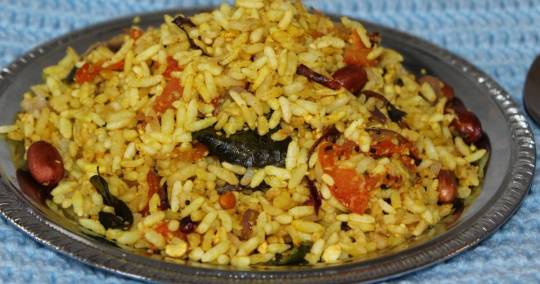
Kurnool Special Uggani is not just a snack; it's a culinary delight that celebrates the rich flavors of Rayalaseema cuisine. With its simple yet flavorful ingredients and easy preparation method, this dish is sure to become a favorite among food enthusiasts seeking an authentic taste of India. So, gather your ingredients, follow the recipe, and treat yourself to a super delicious serving of Rayalaseema Kurnool Special Uggani!
3 notes
·
View notes
Text
How Asafoetida Elevates Your Everyday Dal Tadka
When it comes to Indian cooking, few ingredients are as distinctive and essential as Hing. Also known as Asafoetida, this potent spice brings an unparalleled depth of flavor to a variety of dishes. Today, we'll explore how Hing transforms a humble Dal Tadka into a culinary masterpiece.

What is Hing?
Hing or Asafoetida is a dried latex exuded from the rhizome or taproot of several species of Ferula, a perennial herb. Known for its strong, pungent smell, it mellows out when cooked, imparting a smooth, garlicky flavor. This makes it a staple in Indian kitchens, particularly in vegetarian recipes where it enhances the umami taste without using meat.
Why Use Hing in Dal Tadka?
The use of Hing in Dal Tadka not only boosts its flavor profile but also aids in digestion, making it a healthy addition to your meals. The combination of Hing, cumin, mustard seeds, and ghee creates a complex, aromatic base that transforms the simple lentils into something extraordinary.
Recipe: Dal Tadka with Hing
Ingredients:
1 cup split yellow lentils (toor dal)
1 medium onion, finely chopped
1 medium tomato, finely chopped
2 green chilies, slit
1 teaspoon ginger-garlic paste
1/2 teaspoon turmeric powder
1 teaspoon cumin seeds
1/2 teaspoon mustard seeds
1/4 teaspoon Hing (Asafoetida)
2 tablespoons ghee (clarified butter) or oil
Salt to taste
Fresh coriander leaves for garnishing
For Tadka (Tempering):
2 tablespoons ghee or oil
1 teaspoon cumin seeds
1 teaspoon mustard seeds
2 dried red chilies
1/4 teaspoon Hing (Asafoetida)
1 teaspoon red chili powder
2-3 cloves garlic, finely sliced
Instructions:
Cook the Lentils:
Wash the toor dal thoroughly and soak it in water for 15-20 minutes.
Pressure cook the soaked dal with turmeric powder, salt, and 3 cups of water for 3-4 whistles or until soft. Once done, mash the dal slightly and set it aside.
Prepare the Dal:
In a large pan, heat 2 tablespoons of ghee or oil over medium heat.
Add cumin seeds and mustard seeds. When they start to splutter, add Hing (Asafoetida).
Add chopped onions and sauté until golden brown.
Add ginger-garlic paste and slit green chilies. Sauté for another 1-2 minutes until the raw smell disappears.
Add chopped tomatoes and cook until they turn soft and mushy.
Pour in the cooked dal, mix well, and bring to a boil. Adjust the consistency by adding water if needed. Simmer for 5-7 minutes.
Prepare the Tadka:
In a small pan, heat 2 tablespoons of ghee or oil.
Add cumin seeds, mustard seeds, dried red chilies, and Hing (Asafoetida). When they start to splutter, add sliced garlic and sauté until golden brown.
Add red chili powder and immediately pour this tadka over the simmering dal.
Garnish and Serve:
Mix the dal well and garnish with fresh coriander leaves.
Serve hot with steamed rice or Indian bread (roti/chapati).
Where to Buy Hing?
To experience the true essence of this recipe, it’s important to use Premium Hing. You can easily Buy Hing Online from various reputed sources. Look for Strong Asafoetida or Solid Hing for the best results.
Conclusion
Incorporating Hing (Asafetida Hing) into your Dal Tadka not only enhances its flavor but also offers numerous health benefits. This magical spice is a must-have in every kitchen, providing a unique taste that elevates simple dishes to gourmet levels. So next time you cook, remember to add a pinch of Hing and enjoy the difference it makes.
0 notes
Text
Spice Up Your Life – The Ultimate Guide to Making Homemade Red Chilli Pickle
Red chilli pickle is a beloved condiment in Indian cuisine, renowned for its fiery flavor and ability to add a punch to any meal. Whether enjoyed with parathas, rice, or as a side to your favorite curry, red chilli pickle is a versatile and delicious addition to any dining table. In this comprehensive guide, we will walk you through the steps to create your own homemade red chilli pickle, ensuring that you can enjoy this spicy delight whenever you desire.
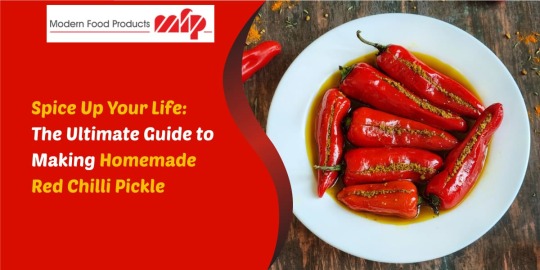
The Art of Pickling Red Chillies
Ingredients:
Fresh red chillies
Mustard seeds
Fenugreek seeds
Asafoetida (hing)
Turmeric powder
Salt
Mustard oil
Vinegar
Method:
1. Prepare the Chillies:
Wash the red chillies thoroughly and pat them dry.
Remove the stems and slice the chillies lengthwise into halves or quarters, depending on your preference. Be sure to wear gloves to protect your hands from the fiery heat of the chillies.
2. Dry Roast the Spices:
In a dry pan, lightly roast the mustard seeds and fenugreek seeds until fragrant. Allow them to cool, then grind them into a coarse powder using a mortar and pestle or spice grinder.
3. Prepare the Pickling Masala:
In a bowl, mix together the ground mustard seeds, fenugreek seeds, turmeric powder, asafoetida, and salt to taste. This aromatic masala will form the base of your red chilli pickle.
4. Marinate the Chillies:
Place the sliced red chillies in a clean, dry glass jar.
Add the pickling masala to the jar, ensuring that the chillies are well-coated with the spice mixture.
5. Add Vinegar and Oil:
Pour enough vinegar into the jar to cover the chillies completely.
Heat mustard oil in a pan until it reaches smoking point, then allow it to cool slightly. Pour the cooled mustard oil over the chillies until they are fully submerged.
6. Let it Mature:
Seal the jar tightly and store it in a cool, dark place for at least a week to allow the flavors to meld and develop. Your homemade red chilli pickle will continue to improve in flavor over time.
Why Make Your Own Red Chilli Pickle?
While there are many commercial varieties of red chilli pickle available in the market, making your own at home offers several distinct advantages:
1. Freshness: By making your own red chilli pickle, you can ensure that you are using the freshest ingredients available, resulting in a superior flavor and texture.
2. Customization: Homemade red chilli pickle allows you to tailor the level of spiciness and seasoning to suit your personal taste preferences. You can experiment with different varieties of red chillies and spices to create a pickle that is uniquely yours.
3. Quality Control: When you make your own red chilli pickle, you have full control over the quality and purity of the ingredients used. You can avoid additives, preservatives, and artificial colors commonly found in commercial products.
4. Satisfaction: There is a sense of satisfaction that comes from creating something delicious from scratch in your own kitchen. Homemade red chilli pickle is a labor of love that you can proudly share with family and friends.
Red Chilli Pickle Supplier and Manufacturer in India
As a leading food product company in India, we take pride in offering high-quality red chilli pickle made from the finest ingredients sourced from trusted suppliers. Our state-of-the-art food processing facilities ensure that our red chilli pickle is manufactured under strict hygiene and quality standards, preserving its freshness and flavor.
Whether you are a fan of traditional spicy pickles or prefer a milder, tangier flavor, our range of red chilli pickles caters to every palate. From classic recipes to innovative twists, we strive to delight our customers with our diverse selection of pickled delights.
Spice Up Your Meals with Homemade Red Chilli Pickle
In conclusion, making homemade red chilli pickle is a rewarding culinary experience that allows you to savor the vibrant flavors of Indian cuisine in the comfort of your own home. With just a few simple ingredients and some patience, you can create a mouthwatering condiment that will elevate any meal to new heights of deliciousness.
Whether you are a seasoned cook or a novice in the kitchen, making red chilli pickle is a fun and rewarding endeavor that is sure to impress your taste buds. So why wait? Gather your ingredients, roll up your sleeves, and embark on a flavorful journey as you create your own homemade red chilli pickle. Your taste buds will thank you!
#Food processing industry#Food product company in India#Red chilli pickle manufacturer#Red chilli pickle Supplier in India#Red Chilli Pickle#Food manufacturing companies in Vadodara#Food manufacturing companies#Private Labelling services#Food industries in Vadodara#best food product company in vadodara#canned foods#bottled items#ketchup#flavor#hot sauce
3 notes
·
View notes